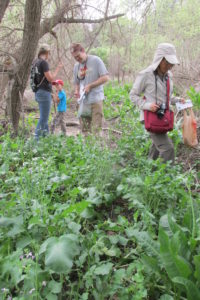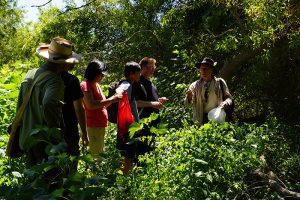
- This event has passed.
SEASONAL SPRING FORAGING — wild foods and useful plants by the Season
March 22 @ 10:00 am - 2:00 pm
$45.00 – $65.00
Saturday, March 22, 10 a.m.
SPRING FORAGING, part of our ETHNO-BOTANY SERIES
Spring is the time of peak leaf production, when the native and non-native plants are sprouting up everywhere. It’s typically still a bit cooler, and everything is greening up. However, here in Southern California, we’d had only light rain this season, so many areas are already drying up. This means we’ll discuss what’s available now, and learn which are useful for food, and learn how to collect them sustainably. In some cases, you’ll be learning how to recognize sprouts which you can come back later for harvesting.
The young new growth of prickly pear cactus occurs now, so this is the best time to collect it. (However, you can harvest prickly pears year round). Some barks are best collected now, such as willow. Some fruits occur early, and we’ll see those. Some non-natives, like mustard, flower early, and can be readily collected and used for food or medicine. Learn how some of these can also be dried and stored for later use.
Join us and learn what edible salad plants may be growing right in your backyard, your local neighborhood, and in the wild area this spring. Learn the plants which can be foraged and made into nutritious food with simple recipes. You’ll get to see the images and learn about the diverse uses.
We’ll also share with you a way to look at the environment to see what the future will bring in terms of foraging. We offer this Seasonal Foraging walk four times a year, so that you can learn how to “read” the environment. A great Survival Skill!
Upper Arroyo, we will send registrants the exact meeting location. Bring along water.

WILD FOOD AND USEFUL PLANTS BY THE SEASON
This series of workshops, one per season, allows you to see nature through the seasons, from a forager’s perspective. The essence of this class is to develop seasonal knowledge and observational skills: How to look, where to look, what to look for. Plus, we will also focus on responsible and sustainable gathering methods, including collection of seeds and cuttings so you can grow plants in your own backyard.
This workshop occurs one per season, so you can learn to see nature through the seasons, from a forager’s perspective. The essence of this class is to develop seasonal knowledge and observational skills: How to look, where to look, what to look for. Plus, we will also focus on responsible and sustainable gathering methods, including collection of seeds and cuttings so you can grow plants in your own backyard.
You’ll learn how to identify and collect foods, medicines, soaps, fire-materials, and other useful parts of plants. You’ll learn to think like foragers of the past, who had to have an intimate knowledge of the seasons, and foresight for the future. (For example, sometimes you do NO foraging in an area if the plant or seed is not abundant.)
Join us each quarter for an insightful walk into a wild area, with a focus on interpreting what’s available that season. Each session will include demonstrations, hands-on practice, and sampling of the seasonal foods, such as salad, soup, biscuit, or tea. Each session includes a list of what is normally available in that season.
SPRING FORAGING
Spring is the time of peak leaf production, when the native and non-native plants are sprouting up everywhere. It’s typically still a bit cooler, and everything is greening up. This means we’ll discuss what’s available now, and learn which are useful for food, and learn how to collect them sustainably. In some cases, you’ll be learning how to recognize sprouts which you can come back later for harvesting.
The young new growth of prickly pear cactus occurs now, so this is the best time to collect it. (However, you can harvest prickly pears year round). Some barks are best collected now, such as willow. Some fruits occur early, and we’ll see those. Some non-natives, like mustard, flower early, and can be readily collected and used for food or medicine. Learn how some of these can also be dried and stored for later use.
Join us and learn what edible salad plants may be growing right in your backyard, your local neighborhood, and in the wild area this spring. Learn the plants which can be foraged and made into nutritious food with simple recipes. You’ll get to see the images and learn about the diverse uses.
We’ll also share with you a way to look at the environment to see what the future will bring in terms of foraging. We offer this Seasonal Foraging walk four times a year, so that you can learn how to “read” the environment. A great Survival Skill!